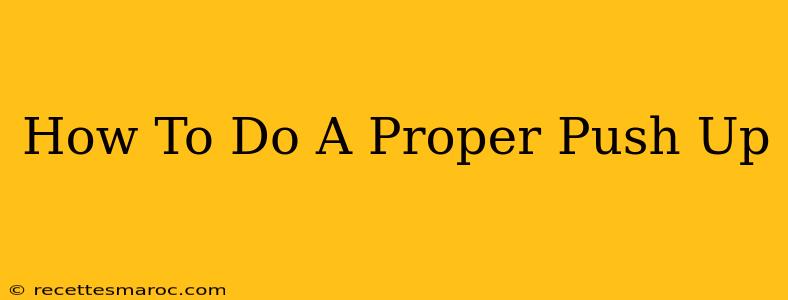Push-ups. The quintessential bodyweight exercise. Simple yet incredibly effective, they're a cornerstone of any fitness routine, building strength, endurance, and stability. But are you doing them correctly? Improper form can lead to injury and limit your results. This comprehensive guide will walk you through the perfect push-up, ensuring you maximize your gains while minimizing your risk.
The Anatomy of a Perfect Push-Up
Before we dive into the specifics, let's understand the muscles involved. A proper push-up primarily works your:
- Pectoralis Major (Chest): The large muscle covering your chest, responsible for the pushing motion.
- Triceps Brachii (Back of Upper Arm): Essential for elbow extension and overall push-up power.
- Anterior Deltoids (Front of Shoulders): These muscles assist in the pushing motion and contribute to shoulder stability.
- Core Muscles (Abdominals and Back): Crucial for maintaining proper body alignment and preventing injury. These muscles are often overlooked, but are just as important as the prime movers.
Step-by-Step Guide to Performing a Push-Up
-
Starting Position: Begin in a plank position, hands slightly wider than shoulder-width apart, fingers pointing forward or slightly outward. Your body should form a straight line from head to heels. Engage your core – this is crucial for maintaining proper alignment. Don't let your hips sag or your butt stick up in the air.
-
The Descent: Slowly lower your chest towards the floor by bending your elbows. Keep your elbows slightly tucked in, around a 45-degree angle to your body. Avoid letting your elbows flare out to the sides, as this puts unnecessary stress on your shoulder joints.
-
The Ascent: Push back up to the starting position, extending your arms fully but avoiding locking your elbows. Maintain a controlled movement throughout the entire exercise. Avoid jerky movements or bouncing off the floor.
-
Breathing: Inhale as you lower your body and exhale as you push back up. Controlled breathing helps with maintaining proper form and rhythm.
-
Repetitions and Sets: Start with as many repetitions as you can perform with good form. Aim for 3 sets. As you get stronger, gradually increase the number of repetitions and sets.
Common Push-Up Mistakes to Avoid
- Sagging Hips: This compromises your core engagement and puts extra strain on your lower back.
- Flared Elbows: This increases the risk of shoulder injury.
- Incomplete Range of Motion: Don't cheat your reps by not lowering your chest all the way down.
- Arching your back: This puts undue stress on your spine.
- Rushing the movement: Control is key to a proper push-up.
Variations for Different Fitness Levels
- Knee Push-Ups: A great modification for beginners. Perform the push-up on your knees, reducing the load on your upper body.
- Incline Push-Ups: Perform the push-up with your hands elevated on a bench or wall. This makes the exercise easier.
- Decline Push-Ups: Place your feet elevated on a bench. This increases the difficulty.
- Diamond Push-Ups: Place your hands close together, forming a diamond shape. This targets your triceps more intensely.
- Wide Push-Ups: Increase the distance between your hands to target your chest more.
Beyond the Basics: Incorporating Push-Ups into Your Workout
Push-ups are incredibly versatile. Incorporate them into your routine in various ways:
- Warm-up: A few sets of push-ups can effectively warm up your chest, shoulders, and triceps.
- Workout: Include push-ups as part of your strength training routine.
- Circuit Training: Add push-ups to your circuit training for a full-body workout.
- Challenge yourself: Try different variations and increase the difficulty.
Mastering the proper push-up technique is crucial for maximizing its benefits and avoiding injury. By following this guide, you can ensure you're performing the exercise correctly and reaping its many rewards. Remember, consistency and proper form are key to building strength and achieving your fitness goals.

